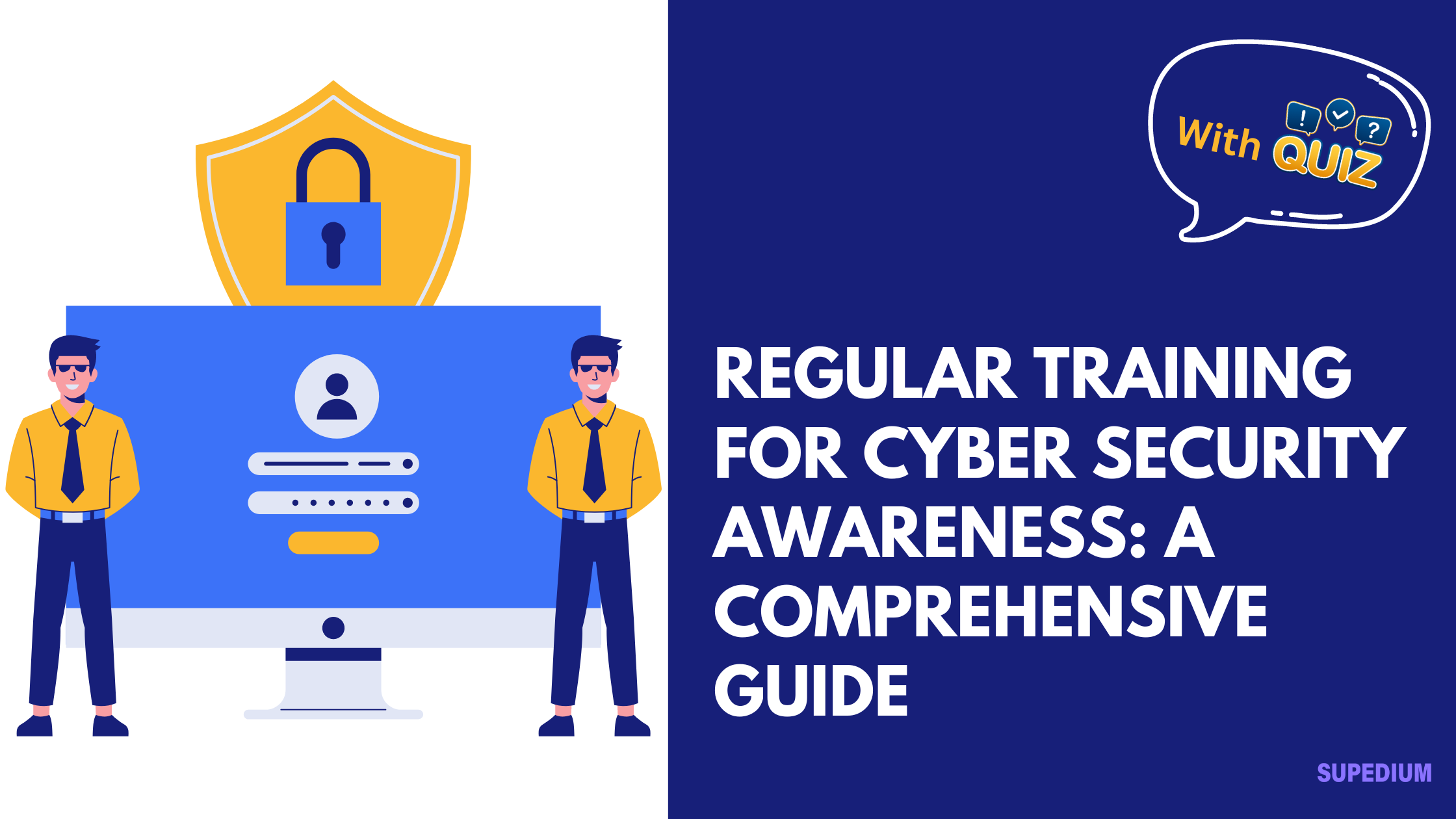Table of Contents
- 0.0.1 I. Introduction
- 0.0.2 II. The Current Cyber Threat Landscape
- 0.0.3 III. Key Components of Effective Cyber Security Training
- 0.0.4 IV. Implementing a Cyber Security Training Program
- 0.0.5 V. Measuring the Effectiveness of Training
- 0.0.6 VI. Challenges and Solutions
- 0.0.7 VII. Case Studies and Best Practices
- 0.0.8 VIII. Conclusion
- 1 Quiz Time
![]()
I. Introduction
In an era where digital transformation is accelerating and cyber threats are becoming increasingly sophisticated, cyber security awareness has never been more critical. Regular training for cyber security awareness is essential for safeguarding organizational assets, maintaining trust, and ensuring compliance with regulatory requirements. This article provides a comprehensive guide to understanding and implementing effective regular training for cyber security awareness.
II. The Current Cyber Threat Landscape
Understanding the current cyber threat landscape is crucial for designing effective training programs. Cyber threats are diverse and evolving, with new types and variants emerging regularly. Common threats include:
- Phishing Attacks: These attacks involve fraudulent attempts to obtain sensitive information by disguising oneself as a trustworthy entity in electronic communications.
- Ransomware: This malicious software encrypts a victim’s data and demands a ransom for the decryption key, causing significant operational and financial damage.
- Malware: Malicious software designed to disrupt, damage, or gain unauthorized access to computer systems.
- Social Engineering: Manipulating individuals into divulging confidential information through deceptive means.
Emerging threats such as Advanced Persistent Threats (APTs), Internet of Things (IoT) vulnerabilities, and supply chain attacks further complicate the security landscape. APTs involve prolonged and targeted cyber-attacks, often by sophisticated adversaries. IoT devices often have weak security, making them prime targets for exploitation. Supply chain attacks target vulnerabilities in the software and hardware supply chain, impacting multiple organizations.
The impact of these threats can be severe, including financial losses, reputational damage, and legal consequences. Hence, keeping employees informed and prepared through regular training is vital.
III. Key Components of Effective Cyber Security Training
Effective cyber security training consists of several key components:
- Initial Training for New Employees:
- Introduction to Organizational Policies: New employees should be familiarized with the organization’s cyber security policies and procedures.
- Basic Security Practices: Training should cover fundamental security practices such as creating strong passwords, recognizing phishing attempts, and securing personal devices.
- Regular Refresher Courses:
- Frequency and Timing: Refresher courses should be conducted regularly, at least annually, or more frequently if significant changes occur in the threat landscape or organizational policies.
- Updates on New Threats and Techniques: These courses should include the latest information on emerging threats and new security technologies.
- Specialized Training for Different Roles:
- IT and Security Staff: Advanced training focused on technical aspects of security, threat detection, and incident response.
- Executives and Management: Training on risk management, strategic decision-making, and understanding the broader impact of cyber threats.
- General Staff and End-Users: Basic security practices relevant to daily tasks, such as identifying phishing emails and securing sensitive data.
- Interactive and Engaging Training Methods:
- Simulations and Role-Playing: Realistic scenarios that mimic potential threats can help employees practice their response strategies.
- Gamification: Incorporating game-like elements can make learning more engaging and memorable.
- Case Studies and Real-World Examples: Analyzing actual incidents helps contextualize the importance of security practices.
IV. Implementing a Cyber Security Training Program
Implementing a successful cyber security training program involves several steps:
- Developing a Training Plan:
- Assessing Training Needs: Identify the specific needs of different employee groups based on their roles and responsibilities.
- Setting Objectives and Goals: Define clear objectives for the training program, such as improving threat recognition or enhancing response capabilities.
- Designing Content and Curriculum: Develop content that is relevant, up-to-date, and tailored to the audience’s needs.
- Choosing Training Delivery Methods:
- In-Person Workshops: Interactive sessions that provide hands-on experience and facilitate direct feedback.
- Online Courses and Webinars: Flexible options that allow employees to learn at their own pace and from any location.
- Hybrid Approaches: Combining in-person and online methods to maximize engagement and accessibility.
- Integrating Training into Organizational Culture:
- Leadership Involvement: Ensure that senior management supports and participates in the training program, emphasizing its importance.
- Encouraging a Security-First Mindset: Promote a culture where security is prioritized and considered in all business processes.
- Promoting Continuous Learning: Encourage ongoing education and awareness beyond formal training sessions.
V. Measuring the Effectiveness of Training
To ensure the effectiveness of a cyber security training program, it is essential to measure its impact:
- Key Performance Indicators (KPIs):
- Completion Rates: Track the number of employees who complete training programs.
- Knowledge Retention: Assess employees’ understanding and retention of key concepts through quizzes and assessments.
- Behavior Changes and Incident Reduction: Monitor changes in employee behavior and reductions in security incidents.
- Feedback Mechanisms:
- Surveys and Assessments: Collect feedback from participants to gauge their perceptions of the training’s relevance and effectiveness.
- Employee Feedback: Gather input from employees on their experiences and suggestions for improvement.
- Continuous Improvement:
- Analyzing Feedback and Performance Data: Use feedback and performance data to identify areas for improvement.
- Updating Training Materials: Regularly review and update training content to reflect the latest threats and best practices.
- Adapting to New Threats and Technologies: Adjust training programs to address emerging threats and technological advancements.
VI. Challenges and Solutions
Implementing regular cyber security training comes with its challenges:
- Overcoming Resistance to Training:
- Addressing Perceived Lack of Relevance: Make training content relevant to employees’ specific roles and responsibilities.
- Making Training Mandatory: Ensure that participation in training programs is a requirement for all employees.
- Keeping Training Content Up-to-Date:
- Regular Review and Updates: Establish a schedule for reviewing and updating training materials.
- Collaboration with Cyber Security Experts: Work with experts to ensure content reflects current threats and best practices.
- Ensuring Engagement and Retention:
- Interactive Elements: Incorporate engaging elements to maintain interest and improve retention.
- Real-World Applications and Relevance: Use real-world examples to demonstrate the practical importance of security practices.
VII. Case Studies and Best Practices
Examining case studies and best practices can provide valuable insights:
- Examples of Successful Training Programs:
- Case Study 1: A large corporation implemented a comprehensive training program that included regular updates, interactive elements, and role-specific content, resulting in a significant reduction in security incidents.
- Case Study 2: A small business adopted a hybrid training approach, combining online courses with in-person workshops, leading to increased employee engagement and improved security awareness.
- Lessons Learned from Failures:
- Common Pitfalls: Lack of relevance, infrequent updates, and insufficient engagement can undermine training effectiveness.
- Strategies for Improvement: Focus on relevance, update content regularly, and incorporate interactive and engaging elements.
VIII. Conclusion
Regular training for cyber security awareness is a critical component of an organization’s defense strategy. By understanding the current threat landscape, implementing key components of effective training, measuring its effectiveness, and addressing challenges, organizations can enhance their security posture and protect against evolving cyber threats.






Be the first to comment